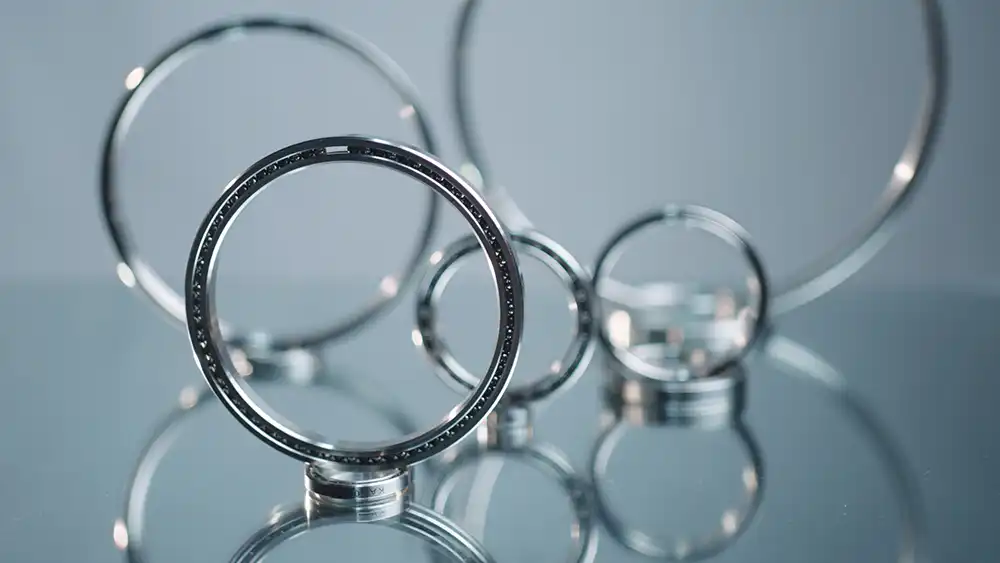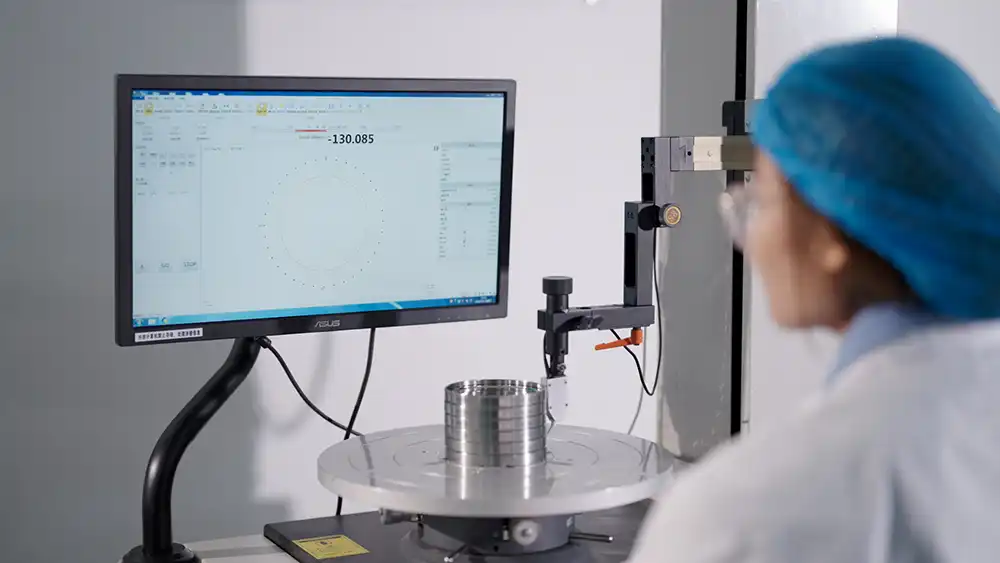What are the Key Features of Metric Thin Section Bearings?
Metric thin section bearings represent a crucial innovation in modern engineering, combining compact design with exceptional performance capabilities. These specialized bearings are characterized by their distinctive cross-sectional profile, where the diameter-to-cross-section ratio is substantially larger than conventional bearings. Their slim profile and precise engineering make them invaluable in applications where space is at a premium, yet high performance and reliability are essential. These bearings have revolutionized various industries, from semiconductor manufacturing equipment to medical devices, by enabling the design of more compact and efficient machinery while maintaining optimal functionality.

How Do Metric Thin Section Bearings Differ from Standard Bearings?
The fundamental distinction between metric thin section bearings and standard bearings lies in their unique dimensional characteristics and construction methodology. These bearings are engineered with a cross-sectional height that remains consistent across various bore diameters, unlike standard bearings where the cross-section typically increases with the bore size. This innovative design approach results in bearings that maintain the same cross-sectional height regardless of their diameter, typically ranging from 10mm to 1000mm, while the cross-sectional height remains remarkably thin, usually between 3mm to 10mm.

The manufacturing process of metric thin section bearings involves sophisticated precision engineering techniques that ensure exceptional roundness and running accuracy. The raceways are ground to extremely tight tolerances, often achieving accuracy levels within micrometers. This precision is crucial because the thin-walled design makes these bearings more susceptible to deformation than standard bearings. Manufacturers employ specialized heat treatment processes and material selection to compensate for this characteristic, ensuring optimal hardness and dimensional stability.
These bearings also feature unique design elements to enhance their performance. The ball complement is carefully optimized to provide maximum load capacity within the confined space. The cage design is particularly critical, as it must maintain proper ball spacing while being robust enough to withstand operational stresses. Many metric thin section bearings incorporate innovative cage materials and designs, such as lightweight polymers or precision-machined metallic cages, to ensure smooth operation and minimal friction.
What Are the Primary Applications and Industries for Metric Thin Section Bearings?
The versatility of metric thin section bearings has led to their widespread adoption across numerous industries and applications. In the semiconductor manufacturing sector, these bearings are essential components in wafer handling equipment, where precise positioning and smooth motion are paramount. The bearings' thin profile allows for the design of compact robotic arms and positioning systems that can operate with the extreme precision required for semiconductor fabrication.

Medical equipment represents another significant application area. In medical imaging devices such as CT scanners and MRI machines, metric thin section bearings enable the smooth rotation of heavy scanning equipment while maintaining the precise positioning necessary for accurate imaging. Their compact design allows for larger bore openings in scanning equipment, improving patient comfort while maintaining structural integrity. In surgical robots and equipment, these bearings facilitate precise movements in space-constrained environments.
The aerospace industry heavily relies on metric thin section bearings in various applications, from satellite positioning systems to aircraft control surfaces. The bearings' lightweight yet robust design makes them ideal for aerospace applications where weight reduction is crucial. In spacecraft applications, these bearings must perform reliably in extreme conditions, including vacuum environments and extreme temperature variations. Manufacturers often employ special lubricants and materials for these applications to ensure long-term reliability.
Industrial automation and robotics represent another major application area. The bearings' thin profile enables the design of compact robotic joints and articulation points, allowing for more complex and efficient robotic systems. In packaging machinery, these bearings facilitate high-speed operation while maintaining precise positioning capabilities. Their use in industrial automation has contributed to the development of more compact and efficient manufacturing systems.
What Maintenance Requirements and Best Practices Should Be Followed for Metric Thin Section Bearings?
The longevity and optimal performance of metric thin section bearings heavily depend on proper maintenance and adherence to best practices. Due to their thin-walled construction, these bearings require careful handling during installation and maintenance procedures. Proper mounting techniques are crucial, as any misalignment can significantly impact performance and service life. Installation tools and procedures specifically designed for thin section bearings should be used to prevent damage during mounting.
Lubrication plays a critical role in the maintenance of these bearings. The selection of appropriate lubricants depends on various factors, including operating conditions, speed, and environmental considerations. In clean room applications, such as semiconductor manufacturing, special low-outgassing lubricants may be required. The lubrication interval and quantity must be carefully controlled, as over-lubrication can be as detrimental as under-lubrication in these precision components.
Regular monitoring of bearing condition is essential for preventive maintenance. This includes periodic inspection of running accuracy, noise levels, and vibration characteristics. Advanced monitoring techniques, such as vibration analysis and temperature monitoring, can provide early warning of potential issues. The thin cross-section makes these bearings particularly sensitive to operating conditions, requiring careful attention to factors such as temperature control and environmental cleanliness.
When handling metric thin section bearings, cleanliness is paramount. Any contamination can cause accelerated wear or damage due to the precise clearances involved. Proper storage procedures must be followed, including maintaining appropriate environmental conditions and using suitable packaging materials. During maintenance operations, clean room conditions may be necessary for certain applications to ensure optimal performance and reliability.

Luoyang Huigong Bearing Technology Co., Ltd. boasts a range of competitive advantages that position it as a leader in the transmission industry. Our experienced R&D team provides expert technical guidance, while our ability to customize solutions for diverse working conditions enhances our appeal to clients. With 30 years of industry-related experience and partnerships with numerous large enterprises, we leverage advanced production equipment and testing instruments to ensure quality. Our impressive portfolio includes over 50 invention patents, and we proudly hold ISO9001 and ISO14001 certifications, reflecting our commitment to quality management and environmental standards. Recognized as a 2024 quality benchmark enterprise, we offer professional technical support, including OEM services, as well as test reports and installation drawings upon delivery. Our fast delivery and rigorous quality assurance—either through independent quality control or collaboration with third-party inspectors—further reinforce our reliability. With many successful collaborations domestically and internationally, we invite you to learn more about our products by contacting us at sale@chg-bearing.com or calling our hotline at +86-0379-65793878.
References
1. SKF Bearing Technical Manual (2023). "Precision Thin Section Bearings Design and Application Guide."
2. Kaydon Bearing Division (2024). "Engineering Guide for Metric Thin Section Bearings."
3. NSK Americas (2023). "Thin Section Bearing Technology and Applications."
4. The Timken Company (2023). "Precision Bearing Selection Guide."
5. Journal of Mechanical Engineering (2023). "Advances in Thin Section Bearing Design and Manufacturing."
6. International Journal of Precision Engineering (2024). "Performance Analysis of Metric Thin Section Bearings in High-Speed Applications."
7. ASME Technical Paper (2023). "Maintenance Strategies for Precision Bearings in Industrial Applications."
8. Machine Design Magazine (2024). "Thin Section Bearings in Modern Robotics Applications."
9. Bearing News Quarterly (2023). "Industry Trends in Precision Bearing Technology."
10. IEEE Robotics and Automation Letters (2024). "Integration of Thin Section Bearings in Advanced Manufacturing Systems."

